
‘Jean-Claude Killy’ 6236 Rolex Datocompax
Every discipline has its greats. Rock has the Stones. Italian has risotto. Le Mans has the 917. Absolute pricks have Kim Jong Un, second only to Jake Paul. But ski racing? Skiing has Jean-Claude Killy. The French alpine skier took home a trifecta of golds in the 1968 Winter Olympics, a dominant force. This skill rocketed the man to public consciousness and early 70s limelight. Rolex have a habit of sponsoring only events or the most established athletes, whatever the discipline. This strategy was in play even then and Killy was in fact a Rolex ambassador. Moreover, he was eventually on the board. And yet, the Rolex which bears his name has hardly been seen on his wrist. It is reported that Killy owned a 6236, but photographic evidence is slim. Nonetheless, the connection is now firmly established and collectors rarely let a good name go free. And it happens to be attached to the one watch which is about as close to true complication as Rolex has ever come. For the complete calendar, as these are more correctly known, this is the archetype.



If you don’t know Rolex very well, you kind of just assume that, ‘Surely there are a few complicated references from all those years right? Maybe a Rolex perpetual calendar from 1962?’ Sort of and no, though that makes my imagination run. In the modern lineup, there’s the Sky-Dweller. But we don’t like to talk about that one. From the golden era there are basically three flavors: the Padellone and 6062 (and associated refs), both astronomical full calendars, and this full calendar chronograph known as the ‘Jean-Claude Killy’. Today, it would be like having a perpetual calendar released named the ‘Federer’; it would be a supernova.
The Killy evolution is comprised of five references: 4768, 4767, 5036, 6036, and this 6236. All boasted a triple calendar and chronograph, all anti-magnetic, and some in Oyster cases. The run covered mid 1940s until the early 60s, or in Rolex years no time at all. This 6236 is the final evolution with a three-piece 36mm Oyster case, close 6s and 9s, and luminous hands. The 6236 was in production for four years, total numbers remain unknown but quite small by market volume. Interestingly, this particular 6236 is a bit famous, having been photographed Collezionare Orologi da Polso Rolex Collecting Wristwatches by Osvaldo Patrizzi, pages 478 and 479. Yes this exact watch is the cover girl for this reference. It has sold before, achieving 445K in ’19 at Phillips. This year, it’s back again. And looking more handsome than ever.

It was in strong condition in ’19 and it still is today. The dial is beautifully preserved. Its case is great, perhaps a light polish but not much. There’s a great bit of patina on the lume, dial and hands, that is all still present. The caseback and lugs are clear of any really significant bashes. Its no wonder Patrizzi chose this one. It’s going to be a fun auction to watch, I’d expect an exceed of ’19 despite the market.








